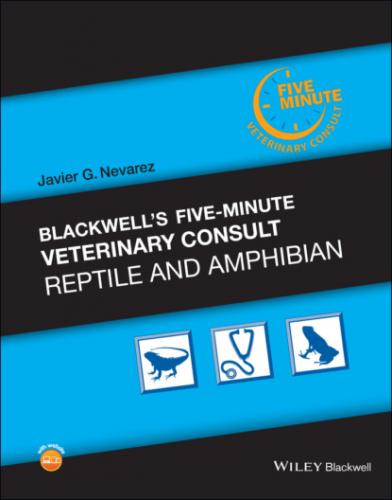Although the etiopathogenesis of otitis is known, there are probably more factors involved in the onset of this disease.
ZOONOTIC POTENTIAL
N/A
SYNONYMS
Otic abscess
Otitis
ABBREVIATIONS
IM = Intramuscular
NSAIDs = nonsteroidal anti‐inflammatory drugs
INTERNET RESOURCES
Center for Avian and Exotic Medicine. Aural Abscesses in Aquatic Turtles. http://avianandexoticvets.com/aural‐abscesses‐in‐aquatic‐turtles
Kik, M JL. Adenovirus infection in reptiles. EAZWV Transmissible Disease Fact Sheet, sheet no. 2, April 2009. https://www.eazwv.org/page/inf_handbook
PetMD Editorial. Ear Infections in Turtles and Tortoises. PetMD July 24, 2008. http://www.petmd.com/reptile/conditions/ears/c_rp_ear_infections
Suggested Reading
1 Christiansen JL, Grzybowski JM, Rinner BP. Facial lesions in turtles, observations on prevalence, reoccurrence, and multiple origins. J Herpetol 2004; 37:293–298.
2 De la Navarre BJS. Diagnosis and treatment of aural abscesses in turtles. Proc ARAV 2000; 7:9–13.
3 Kroenlein KR, Sleeman JM, Holladay SD, et al. Inability to induce tympanic squamous metaplasia using organochlorine compounds in vitamin A‐deficient red‐eared sliders (Trachemys scripta elegans). J Wildl Dis 2010; 44:664–669.
4 McKlveen TL, Jones CJ, Holladay SD. Radiographic diagnosis: aural abscesses in a box turtle. Vet Radiol Ultrasound 2000; 41(5):419–421.
Author Albert Martínez‐Silvestre, DVM, MSc, PhD, DECZM (Herpetology), EBVS European Veterinary Specialist in Herpetological Medicine and Surgery, Acred. AVEPA (Exotic Animals)
Balantidium
DEFINITION/OVERVIEW
Balantidium is a large ciliated protozoal organism that resides within the gastrointestinal tract. The trophozoite is elliptical in shape and ranges in size from 30–300 × 25–120 μm. It is densely covered with cilia along its surface. At the tapered front end lies the cystostome (mouth). Cysts have a thick wall, spherical in shape, and have a kidney bean‐shaped macronucleus. Balantidium testudinis is a species commonly reported in turtle species. They are typically found in herbivorous reptiles. It is debated whether these organisms are considered commensal within reptiles.
ETIOLOGY/PATHOPHYSIOLOGY
Transmission is through the fecal–oral route.
Cysts are ingested and then undergo excystation in the intestinal tract.
Trophozoites inhabit the large colon and replicate by binary fission.
Trophozoites undergo encystation in which infective cysts are formed and then excreted in feces.
Balantidium sp. are facultative parasites and only become pathogenic when other virulence factors such as hyaluronidase are present.
This then allows them to penetrate the intestinal mucosa and cause extensive hemorrhage and necrosis.
Balantidium is generally limited to the large intestinal tract.
In severe infections, the protozoal organisms migrate to the liver and cause abscessation.
SIGNALMENT/HISTORY
No age or sex predisposition
CLINICAL PRESENTATION
Diarrhea
Tenesmus
Inappetence
Weight loss
RISK FACTORS
Husbandry
Improper husbandry
Others
Immunocompromised animals with active parasitic/bacterial infections are more predisposed for the protozoan to become pathogenic.
DIFFERENTIAL DIAGNOSIS
Nyctotherus sp.
DIAGNOSTICS
Microscopic evaluation of fresh fecal material to visualize trophozoites and cysts.
SAF technique can be used for better visualization.
The addition of iodine will stain the contents of the cysts, making them more visible.
PATHOLOGICAL FINDINGS
Hemorrhagic necrotizing colitis
APPROPRIATE HEALTH CARE
N/A
NUTRITIONAL SUPPORT
N/A
CLIENT EDUCATION/HUSBANDRY RECOMMENDATIONS
Practice proper hygiene
Wash fruits and vegetables before being fed
House infected animals separately
DRUG(S) OF CHOICE
Metronidazole 50 mg/kg PO q24h for 7 days
Nimorazole 125 mg/kg PO q24h for 4 days
Tetracyclines 5–10 mg/kg q24h for 5–8 days
PRECAUTIONS/INTERACTIONS
N/A
